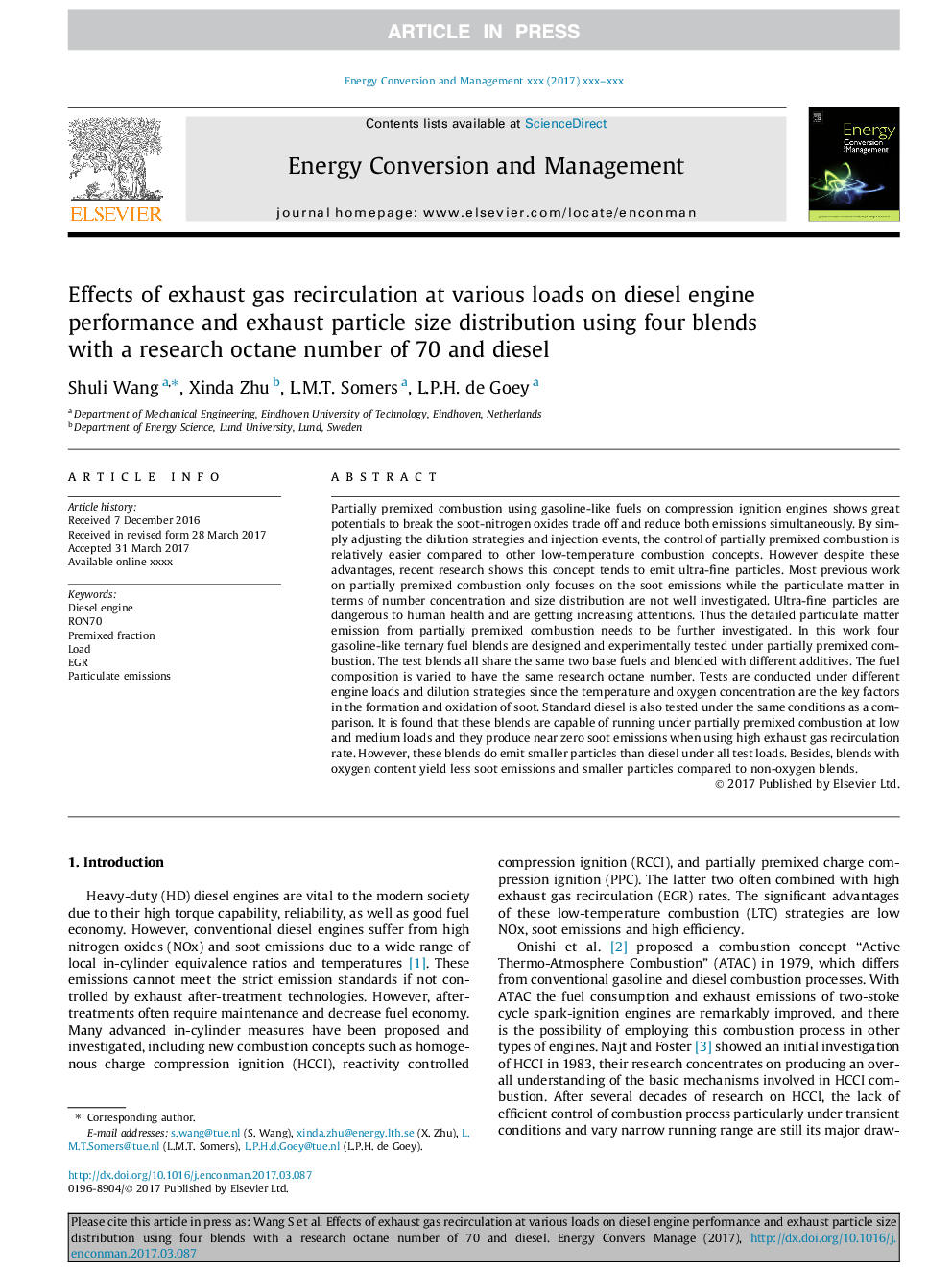| کد مقاله | کد نشریه | سال انتشار | مقاله انگلیسی | نسخه تمام متن |
|---|---|---|---|---|
| 5012473 | 1462813 | 2017 | 10 صفحه PDF | دانلود رایگان |
عنوان انگلیسی مقاله ISI
Effects of exhaust gas recirculation at various loads on diesel engine performance and exhaust particle size distribution using four blends with a research octane number of 70 and diesel
ترجمه فارسی عنوان
تأثیر گاز احتراق گاز در بارهای مختلف بر عملکرد موتور دیزلی و توزیع اندازه ذرات اگزوز با استفاده از چهار مخلوط با تعداد اکتان تحقیقاتی 70 و دیزل
دانلود مقاله + سفارش ترجمه
دانلود مقاله ISI انگلیسی
رایگان برای ایرانیان
ترجمه چکیده
احتراق به طور جزئی از پیش مخلوط شده با استفاده از سوخت های بنزین مانند موتورهای احتراق فشرده سازی، توانایی های بالایی را برای شکستن اکسید های نیتروژن بخار ایجاد می کند و همزمان هر دو گاز را کاهش می دهد. با صرفه جویی در استراتژی های رقت و رویدادهای تزریق، کنترل بخار احتراق پیش تر، نسبتا آسان تر از سایر مفاهیم احتراق کم دما است. اما با وجود این مزایا، تحقیقات اخیر نشان می دهد این مفهوم، ذرات بسیار فوق العاده ای را انتشار می دهد. اکثر کارهای قبلی برای احتراق به طور جزئی از پیش مخلوط تنها بر انتشار گازهای گلخانه ای متمرکز است در حالیکه ذرات با توجه به غلظت تعداد و توزیع اندازه به خوبی مورد بررسی قرار نمی گیرند. ذرات فوق العاده خوب برای سلامتی انسان خطرناک هستند و توجه بیشتری را به خود جلب می کنند. بدین ترتیب، انتشار جزئی از ذرات احتراق پیش از مخلوط، باید بیشتر مورد بررسی قرار گیرد. در این کار، چهار مخلوط بنزینی ترنری با طراحی بنزینی طراحی شده و به صورت آزمایشی در بخشی از احتراق پیش مخلوط مورد آزمایش قرار می گیرند. تست مخلوط همه دو سوخت پایه مشابه را به اشتراک می گذارند و با افزودنی های مختلف ترکیب می شوند. ترکیب سوخت به همان اندازه اکتان تحقیقاتی متفاوت است. تست ها تحت بارهای مختلف موتور و استراتژی های رقیق سازی انجام می شود از آنجا که درجه حرارت و اکسیژن غلظت عوامل کلیدی در شکل گیری و اکسیداسیون دوده است. دیزل استاندارد نیز تحت شرایط مشابه با مقایسه است. یافته شده است که این مخلوط ها قادر به احتراق جزئی با بارگیری کم و متوسط می باشند و در هنگام استفاده از میزان احتراق گاز خروجی بالا، آنها تولید گازهای گلخانه ای نزدیک به صفر را تولید می کنند. با این حال، این مخلوط ذرات کوچکتر از دیزل را در تمام بارهای آزمون آزاد می کند. علاوه بر این، با تولید اکسیژن مخلوط تولید گازهای گلخانه ای کمتر و ذرات کوچکتر را در مقایسه با مخلوط های غیر اکسیژن ترکیب می کند.
موضوعات مرتبط
مهندسی و علوم پایه
مهندسی انرژی
انرژی (عمومی)
چکیده انگلیسی
Partially premixed combustion using gasoline-like fuels on compression ignition engines shows great potentials to break the soot-nitrogen oxides trade off and reduce both emissions simultaneously. By simply adjusting the dilution strategies and injection events, the control of partially premixed combustion is relatively easier compared to other low-temperature combustion concepts. However despite these advantages, recent research shows this concept tends to emit ultra-fine particles. Most previous work on partially premixed combustion only focuses on the soot emissions while the particulate matter in terms of number concentration and size distribution are not well investigated. Ultra-fine particles are dangerous to human health and are getting increasing attentions. Thus the detailed particulate matter emission from partially premixed combustion needs to be further investigated. In this work four gasoline-like ternary fuel blends are designed and experimentally tested under partially premixed combustion. The test blends all share the same two base fuels and blended with different additives. The fuel composition is varied to have the same research octane number. Tests are conducted under different engine loads and dilution strategies since the temperature and oxygen concentration are the key factors in the formation and oxidation of soot. Standard diesel is also tested under the same conditions as a comparison. It is found that these blends are capable of running under partially premixed combustion at low and medium loads and they produce near zero soot emissions when using high exhaust gas recirculation rate. However, these blends do emit smaller particles than diesel under all test loads. Besides, blends with oxygen content yield less soot emissions and smaller particles compared to non-oxygen blends.
ناشر
Database: Elsevier - ScienceDirect (ساینس دایرکت)
Journal: Energy Conversion and Management - Volume 149, 1 October 2017, Pages 918-927
Journal: Energy Conversion and Management - Volume 149, 1 October 2017, Pages 918-927
نویسندگان
Shuli Wang, Xinda Zhu, L.M.T. Somers, L.P.H. de Goey,
